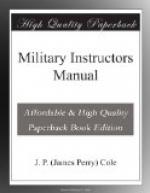1st. To give the individual
a practical knowledge of the working
of the grenades in use.
2nd. To teach him how to throw
them.
3rd. To make him acquainted
with the general principles of
organization and the execution of a grenade attack,
either as a separate operation or as a part of a general
attack. The time spent on any such course of
training is a matter to be settled in the light of
local considerations; but for purposes of preliminary
training of a great number of men a period of two
weeks is usually sufficient, with time allotted according
to some such plan as this: (1) 10 separate half-hour
sessions of practice in throwing from various positions
and at the various targets; (2) 2 hours of study and
a like amount of time spent in a conference for the
purpose of clearing up matters that are hazy.
In this brief time (only 9 hours) the foundation may
be laid for a more thorough training of the specialists
later on. In any such course the use of dummy
grenades should always precede the use of any live
ones; and men should be taught caution above all other
things. This is a point easily lost sight of
when men are using only dummies; but it is well worth
remembering, for obvious reasons.
FIRST: GIVING THE INDIVIDUAL A PRACTICAL KNOWLEDGE OF THE WORKING OF THE GRENADES IN USE.—The differences in the construction and the uses of hand and rifle grenades should be brought out clearly. The various sorts of grenades should be explained and men should not forget the importance of knowing the grenades of the enemy as well as our own. This knowledge may one day prove of no little importance. As has already been stated, the Mills No. 5 is the standard among hand grenades of the Allies. It conforms to the general description of hand grenades; i.e., it is an egg-shaped projectile, more or less hollow, and loaded with a charge of explosive. Besides this it has an apparatus for setting off the bursting charge. It weighs 1 pound 5 ounces approximately, and 4 ounces of this is high explosive. The shell being of serrated cast-iron, an explosion will scatter a sort of shrapnel over an area equal to three times the height. No more need be said of the effectiveness of such a weapon. Among rifle grenades the Mills is also the standard more or less, although the French make great use of a rifle grenade that fits over the muzzle of the rifle, fired by ball cartridge, in contrast to the Mills No. 23, which has a rod running down the barrel of the rifle and which is propelled by the explosion of a blank cartridge. The maximum range of this grenade with a 5-1/2-inch stem is 120 yards, the gun being fired at an angle of 45 degrees. The Newton Improved (a rifle grenade which explodes on contact) has a range of 250 yards; the Hale No. 3 also explodes on contact and has a range of 200-225 yards.
[Illustration: Plate #7]




